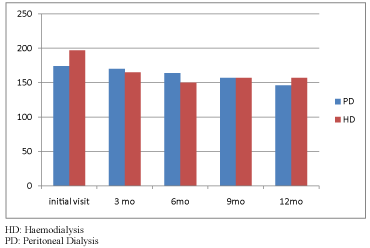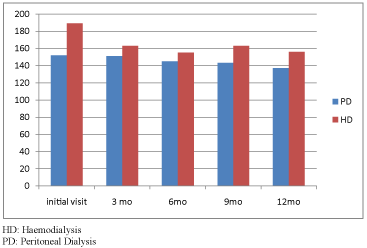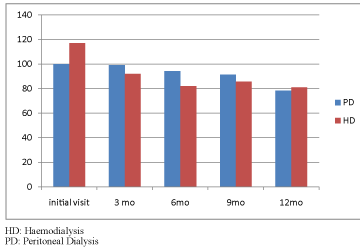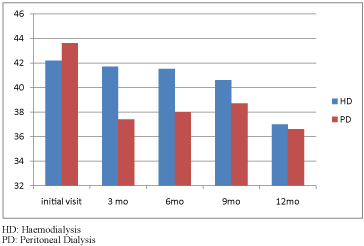| Research Article |
Open Access |
|
| Abdullah Al-Hwiesh* |
| Department of Internal Medicine, King Fahd Hospital of the University, Kingdom of Saudi Arabia |
| *Corresponding authors: |
Abdullah Al-Hwiesh, Chairman
Department of Internal Medicine
King Fahd Hospital of the University
P.O. Box 2208, Al-Khobar 31952
Kingdom of Saudi Arabia
Tel: +966-3-8966741
Fax: +966-3-8966741
E-mail: dralhwiesh@yahoo.com |
|
| |
| Received August 18, 2012; Published October 01, 2012 |
| |
| Citation:Al-Hwiesh A (2012) Study of Lipid Abnormalities in Patients Maintained on Haemodialysis or Automated Peritoneal Dialysis in the Eastern Province of Saudi Arabia. 1:346. doi:10.4172/scientificreports.346 |
| |
| Copyright: © 2012 Al-Hwiesh A. This is an open-access article distributed under the terms of the Creative Commons Attribution License, which permits unrestricted use, distribution, and reproduction in any medium, provided the original author and source are credited. |
| |
| Abstract |
| |
| Background: Hyperlipidemia has since long been known to be an important cardiovascular risk factor in patients with Chronic Kidney Disease (CKD) and in those on dialysis (CKD-5D). Against the large data on lipid abnormalities in patients on Haemodialysis (HD) there are fewer studies in Peritoneal Dialysis (PD) patients which have shown differences in the lipid profiles in two modalities of dialysis. |
| |
| Methods: We analysed the changes in the lipid profile and haemoglobin over 12 month period in our stable end stage renal failure patients on dialysis. The study included 61 CKD-5D patients out of which 21 were on HD while the remaining 40 were on Automated Peritoneal Dialysis (APD). |
| |
| Results: The two groups were comparable except for the fact that males constituted three fourth of haemodialysis population (p<0.05). Total cholesterol and LDL cholesterol values at 12 months in the APD group and at 6, 9 and 12 months in the haemodialysis group were significantly lower as compared to baseline in the respective groups. However, there was no significant difference between the two groups at 3, 6, 9 and 12 months. In addition patient on APD had higher levels of haemoglobin even though they had lower baseline values than the HD patients. |
| |
| Conclusion: Although intra-group changes in the lipid profile could be seen in the total cholesterol and LDL fraction in HD and APD, the study concluded that the modality of dialysis does not affect overall lipid profile. Study is limited by the sample size and number of lipid parameters studied. |
| |
| Keywords |
| |
| Peritoneal dialysis; Haemodialysis; Cholesterol; Lipids |
| |
| Introduction |
| |
| Chronic Kidney Disease (CKD) is known to be associated with major changes in the composition of plasma lipoproteins [1,2]. This alteration may worsen in patients on Maintenance Haemodialysis (MHD), with predominance of the atherogenic triad, i.e., hypertriglyceridemia, elevated VLDL and reduced HDL [3,4]. The pathogenesis of hypertriglyceridemia in patients with CKD is related to an alteration in the composition of circulating triglycerides (which become enriched with apolipoprotein C-III) and their diminished clearance with reductions in the activity of lipoprotein lipase and hepatic triglyceride lipase which are involved in triglyceride removal [2]. The past decade has seen the publication of many studies in the non-uremic population, showing statistically significant reductions in cardiovascular mortality with various lipid-lowering therapies. However, because of the lack of long-term controlled studies, it remains unclear whether these treatments are applicable to patients with ESRD [5]. |
| |
| However, patients on Peritoneal Dialysis (PD) seem to have a more disturbed lipid profile than those on haemodialysis. Several studies have shown that, once dialysis commences, Continuous Ambulatory Peritoneal Dialysis (CAPD) patients develop a somewhat different and probably more atherogenic lipoprotein profile than do Haemodialysis (HD) patients [6-8]. Not all reports agree on the exact differences between the two treatment modalities, but this may not be surprising when one considers that the studies come from ethnically and geographically distinct populations such as northern Europe, southern Europe, and the U.S.A [9-11]. Moreover, compared with uremic patients or those on HD, PD patients appear to have higher LDL and total cholesterol concentrations with similar or lower HDL levels (Figure 1). Furthermore, bias in patient and modality selection will vary from one center to the next. Except another study from Saudi Arabia [12] no major studies have been performed on dyslipidemia in dialysis from Gulf Countries particularly in PD patients. In this study, we analysed the changes in the lipid profile and certain baseline characteristics over 12 month period in our stable end stage renal failure patients on automated peritoneal dialysis and compared with those on HD. |
| |
|
|
Figure 1: Comparison of Cholesterol levels (mg%) at various time interval in PD and HD. |
|
| |
| Materials and Methods |
| |
| This study was carried out in the King Fahd University Hospital, Al Kobar, Saudi Arabia. The study included 61 CKD-5D patients out of which 21 were commenced on haemodialysis while the remaining 40 agreed for peritoneal dialysis. Haemodialysis patients were treated with conventional HD using non cuprophane, low-flux HD membranes and bicarbonate-containing dialysis fluid. Peritoneal dialysis patients were treated with Automated Peritoneal Dialysis (APD). The study was approved by the Hospital Ethics Committee of University of Dammam and was conducted in accordance with the ethical principles described by the declaration of Helsinki. All patients gave written informed consent prior to study enrolment. Patients on either mode of dialysis HD or APD were well nourished (as suggested by anthropometry and serum albumin levels) and adequately dialyzed [13]. The dialysis prescription in all the patients in PD group (all on APD) was night cycler with dialysis solutions supplied by the Baxter Company Ltd (2.27% Dianeal/5 L +1.36% Dianeal /5 L exchanged over 9 hour and last fill of 7.5% Extraneal 2L). All the patients in the HD group had received 3.5 to 4 hr dialysis 3 times a week. The baseline biochemical parameters and patients details were noted during the initial screening period. |
| |
| Analytical methods for lipids |
| |
| Five ml of blood samples were obtained by ante-cubital venipuncture following an overnight fast, prior to heparin and dialysis in HD patients and without interruption of the dialysis schedule in PD patients. Plasma concentrations of total cholesterol and triglycerides were measured by enzymatic procedure. Lipoprotein density classes were isolated by sequential preparative ultra-centrifugation and measured using Dimension® RxL Max® Integrated Chemistry System (Siemens Healthcare Diagnostics Inc. Deerfield, IL USA). VLDL (density <1.006 g/mL), IDL (density 1.006 – 1.019 g/mL), LDL (density 1.019 – 1.063 g/mL) and HDL (density 1.063 – 1.21 g/mL) were isolated at solution densities of 1.006 g/mL, 1.019 g/mL, 1.063 g/mL and 1.21 g/ mL, respectively. All lipoprotein density classes were dialyzed against 0.15 mol/L NaCl containing 0.05% EDTA (pH 7.0). |
| |
| Statistical methods |
| |
| The baseline biochemical parameters and patients details were noted during the initial screening period. Results were expressed as mean ± SD or mean ± SE as indicated. Unpaired “t” test was used to compare mean between the two groups and paired t test was used to compare mean Hb and lipid profile at various time interval and p value <0.05 was considered significant. Statistical calculation was made using “Graph pad prism 5” software. |
| |
| Results |
| |
| Sixty one CKD 5D patients; 40 in peritoneal dialysis and 21 in haemodialysis group. The baseline characters of patients on haemodialysis and peritoneal dialysis is depicted in (Table 1). Thirtyfive individuals were male and 26 were females. The age range of patients in APD and HD was 52 ± 20.55 and 49.57 ± 17.45 years respectively and the BMI the two groups was 30.1 ± 11.5 vs. 25.7 ± 12.4 respective groups. There was no significant difference between the two groups with respect to age and BMI although there were significantly more males in HD group (p value 0.031). The primary cause of ESRD in the study population was Diabetic nephropathy in 30 (49.1%), Chronic glomerulonephritis in 10 (16.3%), Chronic interstitial nephritis in 6 (10%), Hypertensive nephrosclerosis in 8 (13.1%) and diagnosis was not clear in 7 (11.4%) patients. There was no significant difference in basic diagnosis among HD and APD patients. Patients were varying medication including Statins, Beta blockers, Calcium channel blockers, Diureics, Calcium acetate, Sevelamer and Erythropoeitin with no significant difference between HD and PD patients. The details of haemoglobin values and lipid alliterations in APD and HD patients are depicted in table 2. There was significant difference in haemoglobin values at 3, 6, 9 and 12 months when compared to baseline in APD group (p value<0.001) showing an increase from 9.9 ± 0.85 gm/dL at baseline to 11.90 ± 0.98/dL at 12 months. Significant difference was also observed between haemoglobin values at 0, 6, 9 and 12 months between APD and HD groups (p value 0.02, 0.011, 0.007 and <0.001 respectively) with APD patients showing higher values. There was no significant difference in haemoglobin values in HD group. As seen from table 2, the analysis of Lipid parameters showed that Total Cholesterol and LDL-Cholesterol values at 12 months were significantly different from baseline in APD patients (p value 0.024 and 0.020 respectively) with both showing decrease. In HD group, when compared to baseline there was significant difference in Total Cholesterol values at 6, 9 and 12 months (p value 0.05, 0.019 and 0.018 respectively) and also in LDL Cholesterol values at 6, 9 and 12 months (p value 0.003, 0.009 and 0.002 respectively) with both showing a decreasing trend (Table 2). There was no significant difference between HD and APD groups with respect to Total Cholesterol, LDL-Cholesterol, Triglyceride and HDL-Cholesterol (Figures 2-4). Analysis of lipid profile in diabetic versus non-diabetic patients did not reveal any differences in patients in either of dialysis modalities (HD or APD). |
| |
|
|
Table 1: Baseline characteristics. |
|
| |
|
|
Table 2: Lipid profile and hemoglobin in HD and PD patients. |
|
| |
|
|
Figure 2: Triglyceride (mg%) levels at various time intervals in PD and HD groups. |
|
| |
|
|
Figure 3: LDL (mg%) levels at various time interval in PD and HD. |
|
| |
|
|
Figure 4: HDL (mg%) levels at various time interval in PD and HD. |
|
| |
| Discussion |
| |
| Many patients of Chronic Kidney Disease (CKD) Reach End- Stage Renal Disease (ESRD) with established left ventricular hypertrophy, coronary ischemia and disseminated atherosclerotic vascular disease with increased mortality [14,15]. The importance of cardiovascular illnesses as the cause of death in patients with CRF and in patients on dialysis makes it imperative to consider the risk factors involved. Hyperlipidemia has been incriminated as a risk factor of atherosclerotic vascular disease both in non-dialysed and dialysed patients [16,17]. Decreased HDL concentrations with elevated VLDL are common in haemodialysis patients particularly in the presence of hypertriglyceridemia [1-4]. Plasma Low Density Lipoprotein (LDL) cholesterol is usually not elevated in non-diabetic CKD [18,19]. The diminished clearance of triglycerides results from reductions in the activity of lipoprotein lipase and hepatic triglyceride lipase which are involved in triglyceride removal [3,4,20,21]. Gupta et al. [20] had studied lipid profile and Post-Heparin Lipolytic Activity (PHLA) in 21 patients with Acute Renal Failure (ARF), 24 with Chronic Renal Failure (CRF) and 23 healthy volunteers. Plasma triglycerides were significantly elevated in ARF (155.19 ± 72.39 mg/dL) as well as CRF (166.79 ± 72.36 mg/dL), as compared to controls (89.91 ± 23.41 mg/dL, p<0.001). PHLA was determined at 5, 10, 30 and 60 min after intravenous heparin (100 U/kg) and was observed to be reduced in ARF (7.82 ± 1.41 mumol FFA/mL/h) as well as CRF (8.44 ± 1.68 mumol FFA/mL/h) at 10 min, as compared to the values in the control subjects (12.03 ± 2.43 mumol FFA/mL/h, p<0.01). Why lipoprotein lipase activity is reduced in CKD is not well understood but has been thought to reflect increased inhibitor activity. Lower serum concentration of HDL cholesterol is thought to be due to impaired maturation of these particles. A possible contributing mechanism is down regulation of lecithin-cholesterol acyltransferase leading to reduced esterification of cholesterol that is incorporated into HDL [3,4]. In our study total cholesterol and LDL cholesterol showed statistically significant decrease during study period in patients on haemodialysis but hypertriglyceridemia was not seen. However study carried out by de Gómez Dumm et al. [22] did not find any difference in total cholesterol after 30 months of dialysis. Although HDL cholesterol decreased during study period it was not statistically significant. In patients receiving APD hypertriglyceridemia is common as in hemodialysis patients and in addition hypercholesterolemia is frequently seen [6-8]. It was also noted that hypercholesterolemia increases as duration on PD increases. A reduction in serum HDL concentration is commonly observed. It is proposed that reduced total HDL cholesterol is because of its loss in spent dialysate. Many factors contribute to abnormal lipid metabolism in PD patients [23]. Clearly the increased absorption of glucose from dialysate and the loss of protein via peritoneal cavity during PD contribute to dyslipidemia. A reduction in cholesterol, Triglyceride (TG) and Low-Density Lipoprotein (LDL) levels has been reported based upon treatment with icodextrin [24]. Amino acid-based dialysate is also thought to reduce glucose related elevations of lipids [25]. However there was lack of this effect of amino acid or icodextrin dialysate on the dyslipidemia of CAPD patients in another study [26]. No such conclusions could drawn in our study as all the patients were receiving similar APD prescription consisting of 5 L each of Dianeal and Pysioneal with last dwell of icodextrin thus difficulty in studying the differences with different solutions. Comparing both the groups there was no significant difference between HD and PD groups with respect to TC, LDL-C, TG and HDL-C. The results also failed to corroborate the previously held view that peritoneal dialysis patients develop a somewhat different and probably more atherogenic lipoprotein profile than do Hemodialysis (HD) patients [7,8,23]. This may be explained by the fact most of the previous studies had used only dextrose based dialysate where in our study the patients were receiving additional bags of amino-acid and icodextrin both of which have shown to reduce lipid abnormalities as mentioned previously. Our study also does not agree with another similar study from this country which showed that the CAPD patients had worse lipid profile than those on HD, irrespective of age, sex and duration of dialysis [12]. In addition this study had also concluded that the younger patients had more disturbed lipid profile than elderly patients, and females had higher lipid values than males. Patients with mild to moderate chronic kidney disease appear to benefit from Statin Therapy with reduced cardiovascular risk [27]. The mechanism of action of statins based on binding at the active site of the enzyme 3-hydroxy-3-methyl-glutaryl coenzyme A reductase leads to increased expression of Low-Density Lipoprotein (LDL) receptors and a subsequent decrease in LDL cholesterol levels. This beneficial effect of statins has also been observed in patients on dialysis [5,28]. Both haemo and peritoneal dialysis son for masking the expected lipid alteration in our patient population. Baseline Haemoglobin is a predictor of long-term survival in HD and PD patients. Patients with currently recommended haemoglobin levels may benefit from long-term survival [29]. In our study it was noticed that patients on APD had achieved the target haemoglobin levels as compared with the HD patients even though they were receiving lesser dose of erythropoirtin stimulating drugs. |
| |
| Conclusion and Limitations |
| |
| To conclude the modality of dialysis does not affect the lipid profile in CKD-5D patients. PD fluid despite having high glucose content did not alter the lipid profile in our patients. The limitations of the study were the small sample size, short duration of follow-up and no analysis of other atherogenic lipids. |
| |
| Acknowledgements |
| |
| The authors acknowledge with appreciation of the staff of the Peritoneal Unit for providing excellent patient follow up and upkeep of their records. |
| |
| |
| References |
| |
- Pennell P, Leclercq B, Delahunty MI, Walters BA (2006) The utility of non-HDL in managing dyslipidemia of stage 5 chronic kidney disease. Clin Nephrol Nov 66: 336-347
- Abrass CK (2006) Lipid metabolism and renal disease. Contrib Nephrol 151: 106-121.
- Joven J, Vilella E, Ahmad S, Cheung MC, Brunzell JD (1993) Lipoprotein heterogeneity in end-stage renal disease. Kidney Int 43: 410–418.
- Ambrosch A, Domroese U, Westphal S, Dierkes J, Augustin W, et al. (1998) Compositional and functional changes of low-density lipoprotein during hemodialysis in patients with ESRD. Kidney Int 54: 608-617.
- Fellström BC, Holdaas H, Jardine AG (2003) Why do we need a statin trial in hemodialysis patients? Kidney Int Suppl S204-S206.
- Siamopoulos KC, Elisaf MS, Bairaktari HT, Pappas MB, Sferopoulos GD, et al. (1995) Lipid parameters including lipoprotein (a) in patients undergoing CAPD and hemodialysis. Perit Dial Int 15: 342–347.
- Kawaguchi Y, Kubo H, Yamamoto H, Nakayama M, Yokoyama K, etal. (1996) Is atherosclerosis accelerated by CAPD? Perit Dial Int 16: S223-S230.
- Ramos JM, Heaton A, McGurk JG, Ward MK, Kerr DN (1983) Sequential changes in serum lipids and their subfractions in patients receiving Continuous ambulatory peritoneal dialysis. Nephron 35: 20-23.
- Kagan A, Bar-Khayim Y, Schafer Z, Fainaru M (1990) Kinetics of peritoneal protein loss during CAPD: lipoprotein leakage and its impact on plasma lipid levels. Kidney Int 37: 980–990.
- Shoji T, Nishizawa Y, Nishitani H, Yamakawa M, Morii H (1992) High serum lipoprotein(a) concentrations in uremic patients treated with continuous ambulatory peritoneal dialysis. Clin Nephrol 38: 271–276.
- Avram MM, Fein PA, Antignani A, Mittman N, Mushnick RA, etal. (1989) Cholesterol and lipid disturbances in renal disease: the natural history of uremic dyslipidemia and the impact of hemodialysis and Continuous ambulatory peritoneal dialysis. Am J Med 87: 55N–60N.
- Mitwalli AH, Alam AA, Al Wakeel JS, Isnani AC (2011) Dyslipidemia in dialysis patients. Saudi J Kidney Dis Transpl 22: 689-694.
- Debowska M, Waniewski J, Lindholm B (2005) Dialysis adequacy indices for peritoneal dialysis and hemodialysis. Adv Perit Dial 21: 94-97.
- Collins AJ (2003) Cardiovascular mortality in end-stage renal disease. Am J Med Sci. 325: 163-167.
- Go AS, Chertow GM, Fan D, McCulloch CE,Hsu CY (2004) Chronic kidney disease and the risks of death, cardiovascular events, and hospitalization. N Engl J Med 351: 1296–1305.
- Yao Q, Pecoits-Filho R, Lindholm B, Stenvinkel P (2004) Traditional and non-traditional risk factors as contributors to atherosclerotic cardiovascular disease in end-stage renal disease. Scand J Urol Nephrol 38: 405-416.
- Cofan F, Vela E, Cléries M; Collaborative Study Group for Dyslipidemia (2006): Analysis of dyslipidemia in patients on chronic hemodialysis in Catalonia. Atherosclerosis 184: 94–102.
- Kaysen GA (2011) New insights into lipid metabolism in chronic kidney disease. J Ren Nutr 21: 120-123.
- Feingold KR, Grunfeld C, Pang M, Doerrler W, Krauss RM (1992) LDL subclass phenotypes and triglyceride metabolism in non-insulin-dependent diabetes . Arterioscler Thromb 12: 1496–1502.
- Gupta KL, Majumdar S, Sakhuja V (1994) Postheparin lipolytic activity in acute and chronic renal failure. Ren Fail 16: 609-615.
- Boyer JL, Scheig RL (1970) Inhibition of postheparin lipolytic activity in uremia and its relationship to hypertriglyceridemia. Proc Soc Exp Biol Med 134: 603-605.
- de Gómez Dumm NT, Giammona AM, Touceda LA (2003) Variations in the lipid profile of patients with chronic renal failure treated with pyridoxine. Lipids Health Dis 2: 7.
- Horkko S, Huttunen K, Laara E, Kervinen K, Kesaniemi YA (1994) Effects of three treatment modes on plasma lipids and lipoproteins in uremic patients. Ann Med 26: 271–282.
- Bredie SJ, Bosch FH, Demacker PN, Stalenhoef AF, van Leusen R (2001) Effects of peritoneal dialysis with an overnight icodextrin dwell on parameters of glucose and lipid metabolism. Perit Dial Int 21: 275–281.
- García-López E, Lindholm B, Davies S (2012) An update on peritoneal dialysis solutions. Nat Rev Nephrol 8: 224-233.
- Kanbay M, Bavbek N, Delibasi T, Koca C, Kaya A, et al. (2007) Effect of peritoneal dialysis solution type on serum lipid levels in end-stage renal disease. Ren Fail 29: 309-313.
- Shurraw S, Tonelli M (2006) Statins for treatment of dyslipidemia in chronic kidney disease. Perit Dial Int 26: 523-539.
- Goldfarb-Rumyantzev AS, Habib AN, Baird BC, Barenbaum LL, Cheung AK (2007) The association of lipid-modifying medications with mortality in patients on long-term peritoneal dialysis. Am J Kidney Dis 50: 791-802
- Avram MM, Blaustein D, Fein PA, Goel N, Chattopadhyay J, et al. (2003) Hemoglobin predicts long-term survival in dialysis patients: a 15-year single-center longitudinal study and a correlation trend between prealbumin and hemoglobin. Kidney Int Suppl S6-S11.
|
| |
| |




